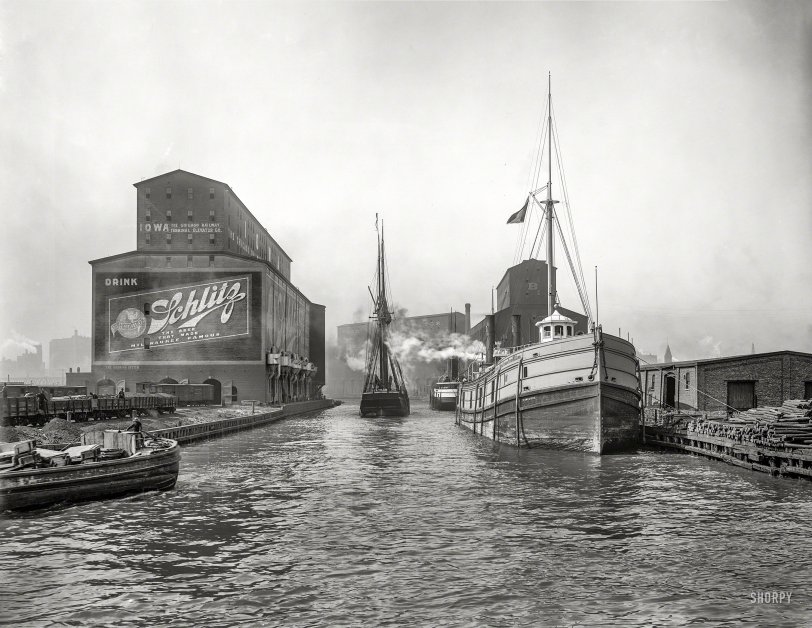


Framed or unframed, desk size to sofa size, printed by us in Arizona and Alabama since 2007. Explore now.
Shorpy is funded by you. Patreon contributors get an ad-free experience.
Learn more.

- Details, Details
- What's that building to the left of the tower?
- Coal Barges
- Bromo-Seltzer
- Inner harbor
- The Basin
- What a headache!
- Giant stepladder?
- Baldwin 62303
- Baldwin VO-1000
- Cold
- No expense spared
- Tough Guys
- Lost in Toyland
- And without gloves
- If I were a blindfolded time traveler
- Smoke Consumer Also Cooks
- Oh that stove!
- Possibly still there?
- What?!?
- $100 Reward
- Freeze Frame
- Texas Flyer wanted
- Just a Year Too Soon
- WWII -- Replacing men with women at the railroad crossing.
- Yes, Icing
- You kids drive me nuts!
- NOT An Easy Job
- I wonder
- Just add window boxes
Print Emporium
Drink Schlitz: 1900

September 1, 1900. "Chicago River elevators at Chicago, Illinois." 8x10 inch dry plate glass negative, Detroit Publishing Company. View full size.
Not A Cold Rolled Steel Special
But good work anyway. You got the name. You got the product. You got your catch phrase. You got the message.

Location
We're looking north along the South Branch of the Chicago River at about 14th Street just west of Clark.
That's the Iowa Elevator on the left built in 1880 & served by the C&NW railroad, and Rock Island Elevators B on the right & A in the background both served by the CRI&P railroad.
Anyone have any information on the sailing ship "Commerce of Cheboygan" in the picture?
The Commodore
Looks like the full inscription on the side of the Commodore is "New York Central & Hudson River RR Line". If so, then a ship named after "Commodore" Cornelius Vanderbilt makes perfect sense. Vanderbilt united his Hudson River RR with the NY Central RR and bought or leased lines all the way to Chicago, including freight shipping lines.
When launched on July 22, 1875, at Cleveland
the Commodore, operated by the New York Central and named in honor of Vanderbilt, was the largest vessel on the Great Lakes. It was retired in 1912 and laid-up at Buffalo. The Illinois Naval Militia purchased the vessel that year and brought it to Chicago as a training platform, and in September 1918 the Navy commissioned it USS Commodore IX-7 where it served as a receiving ship for recruits. The following year it became a naval armory for the Naval Reserve, beached at the site of where a a new land-bound armory would be built in 1929. No longer of use and in the path of the proposed Outer Drive, on December 12, 1930, the vessel was torched and burned to ash at the foot of Randolph Street. The armory that replaced the Commodore was razed in November 1982 so that the notorious "S" curve on the Lake Shore Drive could be straightened and widened.
Grain elevator
The grain elevator does away with the labor-intensive loading and unloading by sack. The basic idea is that the grain is dumped from the rail car through a grate into a hopper underneath, to be conveyed by elevator bucket into a bin or silo, which can then be fed by gravity, auger or conveyor into trucks, barges or other railway cars. A wheat grading system is needed so that one farmer's grain could be combined and stored with another farmer's crop of the same grade. The first steam-powered grain elevator was invented in Buffalo in 1842, but the system flourished and developed in Chicago. I grew up in the land of the wood-cribbed design of grain elevator prevalent throughout Western Canada from the early 1900s though the 1980s. The St. Albert elevators (below) are typical. I also found a colorized alternative of the Chicago view.


The Gunning System
"Outdoor advertising has a certain value which is determined by the character and density of the population. It is a general plan for merchants to follow display advertising out into the rural districts, along the highways, and the larger wholesale stores of the cities even follow the railroads out for considerable distances, where people may read as they ride. This form of advertising is handled, as a rule, by special advertising agencies, such as the Gunning system, who buy up and control space in many communities."
From: “Introduction to Business Organization”
SAMUEL E. SPARLING, Ph.D..
Assistant Professor of Political
Science, University of Wisconsin
(1906)
In the Midwest
In the midwest, the term "elevator" is used for most any grain storage facility.
Elevate the level of conversation
Grain elevators are simply storage bins where grain is collected and stored until it is transferred to a ship or railcar for further movement. In the boxcar era of our photo, boxcars loaded about half full of loose grain were unloaded through grates into the basement, where the grain was then hauled by augur or conveyor [hence, the elevator] up to the top of the facility, where it was dumped into large bins.
Note the chutes along side of the building...here is where the grain was off loaded to a ship or barge. Note also each chute has its own cyclone dust collector attached. Dust is a great danger in elevators, as it is highly explosive. I recall a huge elevator at Texas City, Texas blowing up circa 1970. All that was left was the concrete floor and some rubble.
I refer to all this in the past tense, but grain elevators are still in use today, although the boxcars have been replaced by covered hoppers. This elevator in the photo is a good size for its time, although elevators can get much larger than this one.
Of course, grain elevators are commonly seen many miles from any ship. Farmers haul grain to elevators where the it's collected for movement to a port or manufacturing facility.
Schlitz, the Beer that made Milwaukee Famous
The city of Chicago passed an ordinance in 1900 regulating the size of billboards. The Gunning System was an advertising company typical of those the city was trying to reign rein in. The company took exception to the law and lost in court. The instant ad was obviously done prior to enactment of the ordinance.
The elevator purpose? Prior to the elevators and reliable rail service, Midwestern grain moved to Chicago in fabric sacks. Sacks were suitable in some cases, but loading large amounts of the stuff into ship holds was inefficient and thus costly. The elevator was designed to unload the grain in bulk from rail cars, store it as necessary and then transfer it to ships in bulk. The process is still in use today.

Grain Elevators
SALE OF CHICAGO ELEVATORS.; Milwaukee and St. Paul Railway Makes a Big Purchase.
CHICAGO, Feb. 25. (1899) -- The St. Paul and Fulton elevators were sold to-day to the Chicago, Milwaukee and St. Paul Railway Company for $400,000 by the Chicago Railway Terminal Elevator Company. Within sixty days the railway company will operate them as a part of its system of Chicago terminal houses.
I assume the elevators were each named after landmarks, such as Iowa (in this photo), St Paul, and Fulton. The Chicago Railway Terminal Elevator Company was in the process of winding down its operations. The purchase price for the two elevators ($400,000) is about $11,000,00 in 2016 dollars.
A copy of the original article is here...
http://archives.chicagotribune.com/1899/02/25/page/9/article/big-deal-in...
It all flows downstream
The flow of the Chicago River was reversed eight months before this photo was made. Instead of flowing into Lake Michigan, the river was redirected into the Sanitary and Ship Channel and since January 1900 the Chicago River has emptied into the Mississippi River. Ironically, given the subject of this image, St. Louis' breweries quickly alleged that water from Chicago was ruining the Missouri city's beers, a claim that was later disproven.
Beer Elevators !
Grain elevators are normally a transshipment or storage point for grain. Where I live local farmers bring their harvested grain to the local elevator where it is held till it is sold to different buyers.
A 'wet ship?'
What looks to be rotting planks at the bow of 'Commodore' makes one wonder if she had her pumps running most of the time.
Elevator Purpose?? Anyone know??
What are they used for???
























On Shorpy:
Today’s Top 5